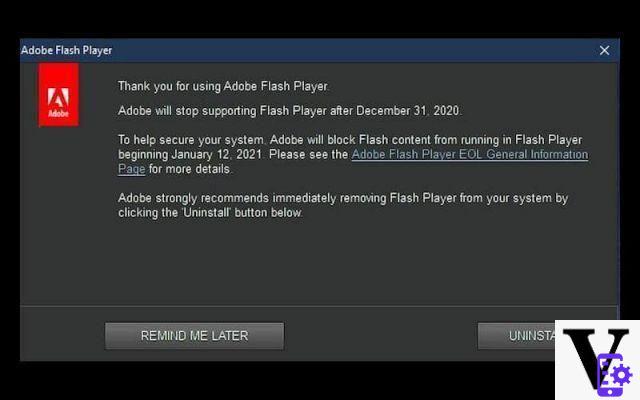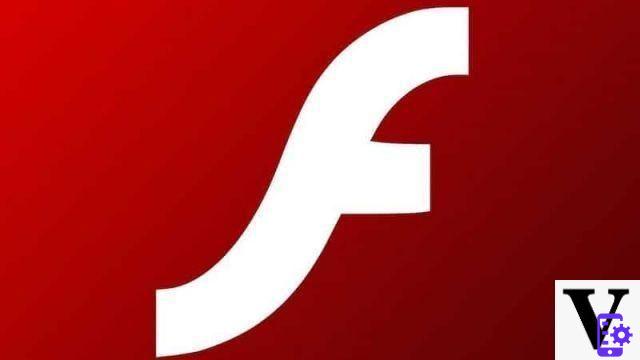Last December 31, when Adobe blocked Flash Player forever, one could say that an era is over.
In his twenty-four years of honorable service, the legendary software for creating vector animations has passed under the fingers of all of us. In fact, it is difficult to think of someone who, regardless of their degree of computer literacy, has never come across a website or an electronic game produced with Flash Player.
So let's retrace the history of Adobe software, starting… from the bottom.
Adobe Flash Player blocked forever: the three dates
There are three pivotal dates that declare the end of the software. The first is the July of the 2017, when (surprisingly early) Adobe announced that Adobe Flash Player would be blocked forever. The second date coincides with the stop to support for the software and related updates, and was the December 31 2020.
Then there is a third date, perhaps less easily memorable but decisive. It is in fact from that moment Flash Player has become in effect inactive: we are talking about the January 12 2021.
The reasons for the closure
The US software house Adobe has considered it appropriate to bid farewell to the software essentially for two reasons. The first concerns the conspicuous use of hardware resources required by some animations, and the other (to which we will return) touches the issue of risks for the safety of those who use it, in the form of malware or an invasion of privacy.
To better understand the functionality of the software, and why Adobe Flash Player has been blocked forever, it is worthwhile to briefly review its history.

The birth of Adobe Flash Player
The Flash Player project kicks off in 1993 thanks to FutureWave Software. The ancestor of the mythical software was called SmartSketch and was used for vector drawing by computers that adopted the PenPoint operating system.
Only in 1996, once taken over by Macromedia, did the project take the name of Flash, and becomes an essential component of the Web of those years.
The move to Adobe and the beginning of the decline
At the end of 2005, in its most successful period, Flash Player is bought by Adobe for about 3,4 billion dollars. But since then the software begins to show its age: lighter and safer programs were making their appearance on the market in the meantime.
Html5 and WebGL, for example, have gradually ousted Flash Player from the role of leader in the production of multimedia content such as videos, animations or games.
In 2015, only 6% of Internet sites required Flash to view videos.
Apple vs. Flash Player
In 2007, Apple also contributed to the slow demise of Flash Player: the first iPhone does not support Flash, and in a note it is Steve Jobs himself who lists the six reasons for giving up the Adobe software, declaring it "inadequate" for any "touch interface". The list is relentless: all the most glaring limits of the product are promptly mentioned.

Flash Player: what was wrong
In fact, Adobe Flash Player has been exploited for years by an impressive number of users, we could say, despite everything.
And that despite everything includes at least three aspects. The securityMeanwhile, as we had already reported some time ago: each new version was running to stem at least in part the problems of privacy vulnerability. This is because, to simplify as much as possible, Flash inserted files similar to cookies into the user's hard disk, difficult to intercept by the most common anti-malware software.
Second question, the considerable weight of the programs that ran in Flash. The consequence was the poor stability of navigation and the blocking of web pages.
Last aspect, usability. Many features of Flash programs were precluded or limited, and some commands responded abnormally. For example, the browser's "forward" and "back" buttons, if clicked, did not land on the next or previous page of the site where you were, but on the next or previous page according to the history of visits.
Discount
 HTML 5 con CSS e Javascript
HTML 5 con CSS e Javascript
- Bochicchio, Daniele (Author)
Adobe Flash Player, despite everything
As obsolete and insecure as it is, Adobe Flash Player animated countless sites before being blocked. And it has produced a bevy of loyal fans.
For this the Internet Archive, an immense non-profit virtual library that since 1996 intends to safeguard the resources of the web (and not only), has created a library reserved for Flash.
In the section you can find thousands of animations and games that have made the history of the Net.
Ruffle, a Flash emulator, was used to make the recovery possible still under development. With one limitation: Ruffle is not compatible with most Flash programs created after 2013.
And so, like any self-respecting cult object, Adobe Flash Player also resists (at least in part) any attempt at imitation.




















![[Review] Samsung Powerbot VR7000: the robot vacuum cleaner from Star Wars](/images/posts/6bc44de38605b5c0fa12661febb1f8af-0.jpg)





